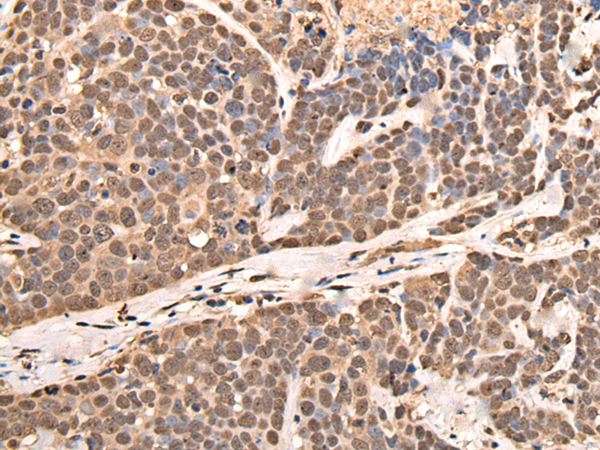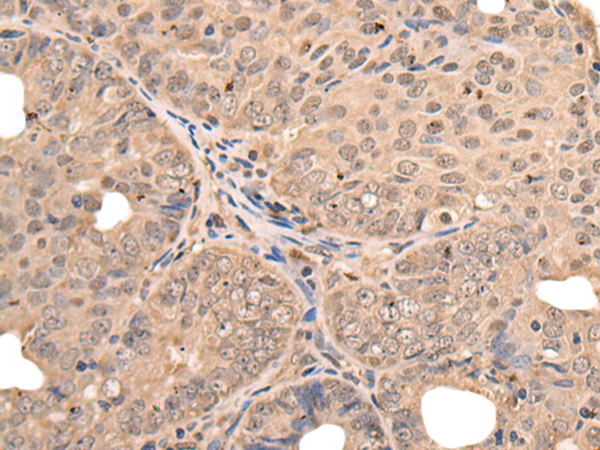


| WB | 咨询技术 | Human,Mouse,Rat |
| IF | 咨询技术 | Human,Mouse,Rat |
| IHC | 1/30-1/150 | Human,Mouse,Rat |
| ICC | 技术咨询 | Human,Mouse,Rat |
| FCM | 咨询技术 | Human,Mouse,Rat |
| Elisa | 1/5000-1/10000 | Human,Mouse,Rat |
| Aliases | ATFA |
| WB Predicted band size | 53 kDa |
| Host/Isotype | Rabbit IgG |
| Antibody Type | Primary antibody |
| Storage | Store at 4°C short term. Aliquot and store at -20°C long term. Avoid freeze/thaw cycles. |
| Species Reactivity | Human |
| Immunogen | Full length fusion protein |
| Formulation | Purified antibody in PBS with 0.05% sodium azide and 50% glycerol. |
+ +
以下是3篇关于ATF7抗体的参考文献及其摘要概括:
---
1. **文献名称**: "ATF7 Mediates Chromatin Assembly in Response to DNA Damage"
**作者**: Liu, Y. et al.
**摘要**: 本研究利用ATF7特异性抗体进行染色质免疫沉淀(ChIP),发现ATF7在DNA损伤后通过招募组蛋白修饰酶(如SUV39H1)介导异染色质形成,从而抑制基因组不稳定性和细胞凋亡。
---
2. **文献名称**: "Stress-Induced Phosphorylation of ATF7 by p38 MAPK Promotes Nuclear Entry and Transcriptional Activation"
**作者**: Tanaka, T. et al.
**摘要**: 通过ATF7抗体的Western blot和免疫荧光实验,揭示了ATF7在氧化应激下被p38 MAPK磷酸化,促进其核转位并激活下游应激响应基因(如热休克蛋白HSP70)的表达。
---
3. **文献名称**: "ATF7 Knockout Mice Reveal Its Essential Role in Spermatogenesis"
**作者**: Wang, L. et al.
**摘要**: 研究通过ATF7抗体检测基因敲除小鼠睾丸组织,发现ATF7缺失导致精子发生异常,其机制与ATF7调控减数分裂相关基因(如SYCP3)的染色质结合能力有关。
---
4. **文献名称**: "Epigenetic Regulation of Inflammatory Genes by ATF7 in Macrophages"
**作者**: Kimura, A. et al.
**摘要**: 使用ATF7抗体的ChIP-seq和RNA干扰技术,证明ATF7通过抑制组蛋白乙酰转移酶(如p300)的募集,负调控巨噬细胞中炎症因子(如TNF-α、IL-6)的转录。
---
以上文献均涉及ATF7抗体的实验应用(如ChIP、Western blot等),并聚焦于ATF7在应激响应、表观遗传调控及疾病机制中的功能。
The ATF7 (Activating Transcription Factor 7) antibody is a tool used to detect and study the ATF7 protein, a member of the ATF/CREB (cAMP response element-binding) family of transcription factors. ATF7 plays a critical role in regulating gene expression in response to cellular stress, including DNA damage and endoplasmic reticulum stress. It binds to cAMP-responsive elements (CREs) in target gene promoters, modulating transcriptional activity. ATF7 is also implicated in chromatin remodeling through interactions with histone H3 lysine 9 trimethylation (H3K9me3), influencing heterochromatin formation and gene silencing.
ATF7 antibodies are widely employed in research applications such as Western blotting, immunohistochemistry (IHC), immunofluorescence (IF), and chromatin immunoprecipitation (ChIP) to investigate ATF7's expression, localization, and functional mechanisms. These antibodies are essential for studying its involvement in cellular processes like apoptosis, proliferation, and differentiation, as well as its association with diseases, including cancer and neurodegenerative disorders. Researchers often validate antibody specificity using knockout cell lines or tissues to ensure accurate detection. Host species (e.g., rabbit, mouse) and clonality (monoclonal/polyclonal) vary, offering flexibility for experimental designs. Understanding ATF7 dynamics aids in unraveling stress-response pathways and potential therapeutic targets.
×